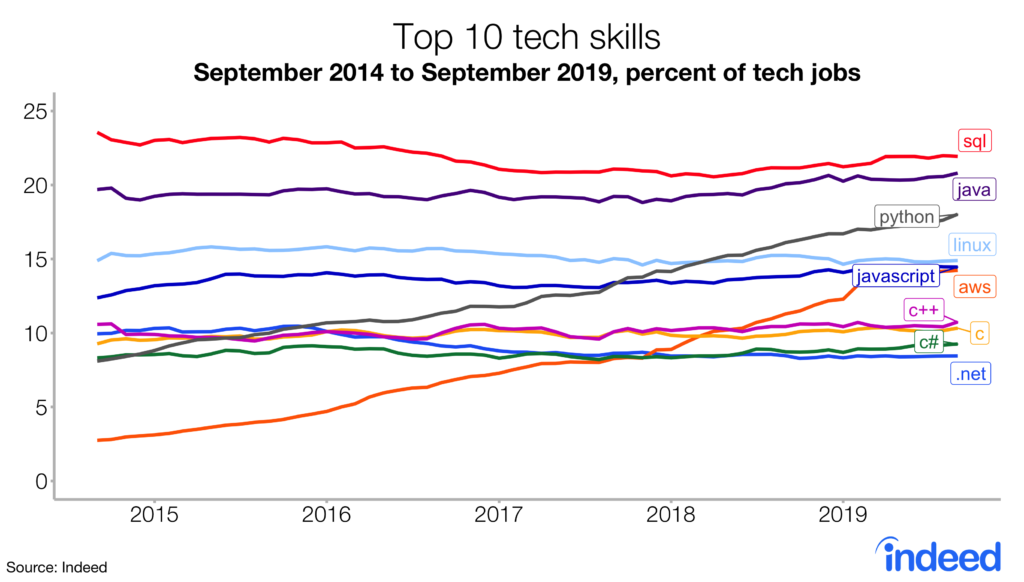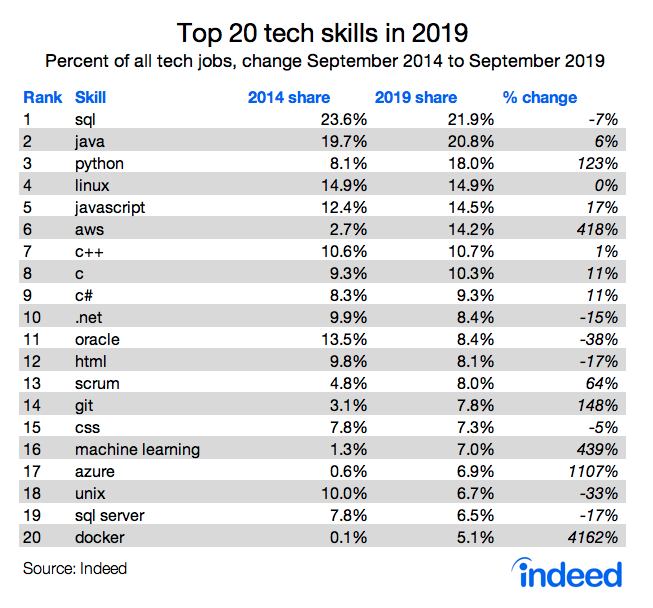This is the first of four parts of the Indeed Tech Skills Explorer — an interactive look at which tech skills are in demand and for which tech jobs. For these reports, we searched for more than 500 tech skills in US postings for tech jobs on Indeed.com.
Key points:
- SQL and Java are the top two tech skills employers want, according to millions of US job postings on Indeed.com between 2014 and 2019.
- Python is the third most common skill, posting strong growth driven partly by data science jobs.
- Amazon Web Services (AWS), at number six, has had even more spectacular growth.
Skills are everything in the tech world. But which skills exactly? What are the tech skills most in demand today? Looking at the millions of US tech jobs posted on Indeed.com over the past five years offers some answers.
As the table below shows, of all the tech skills employers want, SQL came out on top, appearing in 22% of tech job postings in the year ending September 2019. Though it led the pack, SQL’s dominance is fading. Its percentage of appearances in all tech jobs postings fell 7% in the five years ended in September 2019.
Java was a close second, showing up in 21%. Python was number three, listed in 18% of job postings and standing out for remarkable growth since 2014. Some of the surge in Python’s popularity reflects a new mix of jobs, including several growing robustly, like data scientist and data engineer. Linux was number four and JavaScript, which has grown steadily, came in fifth.

Another notable story is the spectacular rise of number six, Amazon Web Services, or AWS for short. Its share in tech job postings skyrocketed more than fivefold from 2014 to 2019. Growth in demand for AWS skills strongly signals the ever-greater importance of cloud computing platforms and services.
Rounding out the top 10 tech skills were several long-established programming languages with modest or flat growth: C++, C, and C#. In tenth place was .NET, which declined in share 15% over the five-year period. Beyond the top ten, Oracle, Unix, and HTML shares of tech job postings dropped 38%, 33%, and 17% respectively.

Behind Python and AWS’s Incredible Growth: Changing Tech Jobs
In September 2014, Python was an also-ran, at number 15 among tech skill on Indeed.com. Five years later, Python had jumped to third place and its share had increased 123%. The rise of AWS was even more stunning — up 418% over the same period, from 39th place to number six.
There’s a story behind this soaring popularity. Of course, software engineers and full stack developers, to name two common tech job titles, increasingly use Python. And those same workers use AWS a lot too. But a big reason behind the exceptional growth of Python and AWS is that the underlying tech job mix is changing in ways that favor these programming languages.
Think of it this way: Tech skills can rise or fall for two reasons. One, more tech jobs require that skill or, two, tech jobs that disproportionately use that skill increase or decrease more than tech jobs overall.
The extraordinary gains of Python and AWS have been driven by the second factor. In particular, as noted in previous posts, tech jobs that disproportionately use Python, like data scientist and data engineer are booming. AWS’s explosive growth is not as closely tied to the rise of data scientist positions. Instead, tech jobs like full stack developer and development operations (“DevOps”) engineer have fueled its rise. The changing job mix — exemplified by the growth of data scientist and full stack developer positions — has fueled the rise of skills like Python and AWS.
Conclusion
Today’s top tech skill is SQL, followed by Java, with Python hot on their heels. JavaScript and especially AWS have grown strongly too. The explosion of data science jobs has been a major contributor to Python’s rise.
Methodology
A list of over 500 tech skill terms was used to query the job descriptions of postings on Indeed.com between September 2014 and September 2019. Only US English language postings having one of these tech job titles were considered. One cautionary note though: Multiple skills can appear in the same job description and some terms can appear in multiple distinct skills, like “SQL” and “SQL server.”
To examine the effect of a changing job mix, we decomposed the change in a skill into two components: skill saturation within jobs (e.g., more postings in a given job title listing Python) and the changing job mix (proportionally more tech postings in jobs that use Python, like data scientist). Holding constant the job mix at the September 2014 level — when the data scientist share of all tech jobs was about a third of what it is now —- shows how the “adjusted” Python trend evolved over time. We repeated this process for AWS and all tech skills studied. Python and AWS stood out for noticeable gaps between their true skill shares and their shares adjusted for the job-mix effect.






